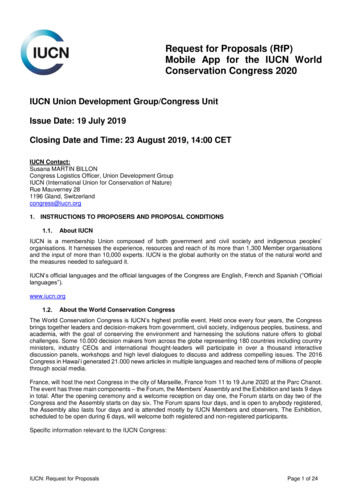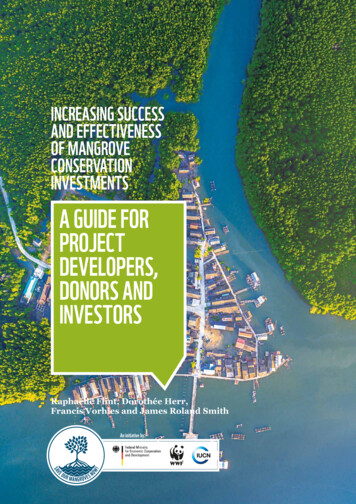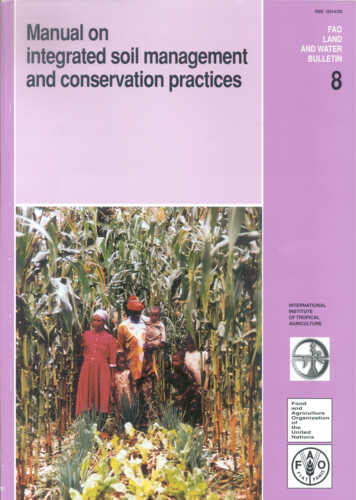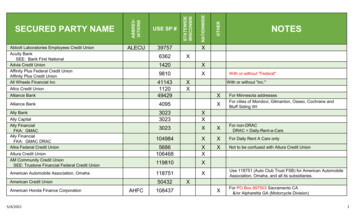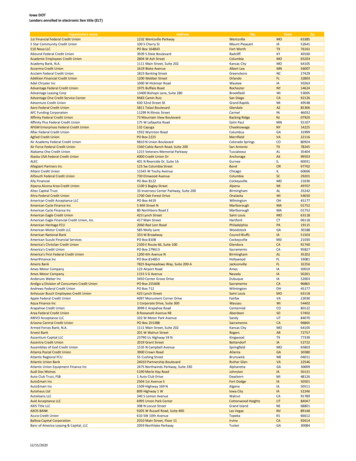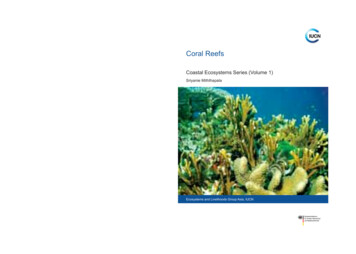
Transcription
IUCN (International Union for Conservation of Nature)Coral ReefsThe IUCN Asia region covers 23Coastal Ecosystems Series (Volume 1)countries, stretching from Pakistan inthe West to Japan in the East, IndonesiaSriyanie Miththapalain the South to Mongolia in the North.IUCN maintains offices in Bangladesh,Cambodia, China, Lao PDR, Nepal,Pakistan, Sri Lanka, Thailand and VietNam. The Asia Regional Office is inBangkok, Thailand.IUCN’ssevenregionalthematicprogrammes, known collectively as theEcosystems and Livelihoods Group AsiaIUCN4/1 Adams AvenueColombo 4Sri LankaPhone: 94 11 2559634Fax: 94 11 2559637E-mail: coastalinfo@iucnsl.orgEcosystems and Livelihoods Group(ELG), are based in two clusters: onehttp: //www.iucn.org/coastalinfo/in Colombo, Sri Lanka (environmentaleconomics,marineandcoastal,species conservation) and one inBangkok,Thailand(environmentallaw, forests, protected areas, wetlandsand water resources). 2008 IUCN, International Union for Conservationof Nature and Natural ResourcesOpinions expressed in this booklet do notnecessarily reßect the ofÞcial views of IUCNor its members.Ecosystems and Livelihoods Group Asia, IUCN
iv
Coral ReefsCoastal Ecosystems Series (Volume 1)Sriyanie MiththapalaEcosystems and Livelihoods Group Asia, IUCN
This document was produced by the financial support of the German Federal Ministry for theEnvironment, Nature Conservation and Nuclear Safety (BMU) through a grant made to IUCN. Theviews expressed in this publication do not necessarily reflect those of IUCN or BMU.The designation of geographical entities in this report, and the presentation of the material, do notimply the expression of any opinion whatsoever on the part of IUCN concerning the legal status ofany country, territory, or area, or of its authorities, or concerning the delimitation of its frontiers orboundaries.Published by:Ecosystems and Livelihoods Group Asia, IUCNCopyright: 2008 IUCN, International Union for Conservation of Nature and NaturalResources.Reproduction of this publication for educational or other non-commercial purposesis authorised without prior written permission from the copyright holder providedthe source is fully acknowledged.Reproduction of this publication for resale or other commercial purposes isprohibited without prior written permission of the copyright holder.Citation:Miththapala, S (2008). Coral Reefs. Coastal Ecosystems Series (Vol 1) pp 1-36 iii.Colombo, Sri Lanka: Ecosystems and Livelihoods Group Asia, IUCN.ISBN:978-955-8177-71-6Cover Photo:Coral reef, Similan island, Thailand Nishan PereraDesign:Sriyanie MiththapalaProduced by:Ecosystems and Livelihoods Group Asia, IUCNPrinted by:Karunaratne & Sons Ltd.67, Industrial Estate,Katuwana Road, Homagama.Available from:Ecosystems and Livelihoods Groups Asia, IUCN4/1 Adams AvenueColombo 4, Sri LankaPhone: 94 11 2559634, Fax: 94 11 2559637E-mail: coastalinfo@iucnsl.orghttp: //www.iucn.org/coastalinfo/
ContentsWhat are corals/types of coral?1What are coral reefs?5Where are coral reefs found in the world?7What is the importance of coral reefs?7What are the threats to coral reefs?12At a glance: services provided by and threats to coral reefs25What is being done to conserve coral 6iii
What are corals/types of coral?Corals are two-layered invertebrates that live in groups (i.e. they are colonial) and arerelated to jellyfish and sea anemones.Corals are made up of tiny individuals called polyps. Each polyp is like a fluid-filled bagwith a ring of tentacles surrounding its mouth, and looks like a tiny anemone. Polyps withina colony are linked by living tissues and can share their food (Allen & Steene, 1994). Insome corals, the polyp extracts calcium carbonate from the sea and secretes it as a cupof calcium carbonate from the bottom half of its body. These cups provide anchoragefor the polyps but when threatened, the polyp can retreat into the safety of the hard cup.When the calcium carbonate cups of many billions of these polyps fuse together, theyform coral reefs (Veron, 2000).There are two main types of corals 1) Stony Corals and 2) Soft Corals.1) Stony (Hard) Corals:Some stony corals obtain their food from one-celled organisms called zooxanthellae.Zooxanthellae are single-celled organisms that use sunlight for photosynthesisand transfer 95% of the food they produce to coral polyps. Both coral and thezooxanthellae benefit from this association. The zooxanthellae receive protectionfrom currents and herbivores, as well as some nutrients from waste produced bycoral polyps. This kind of association - where two different kinds of organismsbenefit from each other - is called a mutualistic association. These corals are calledhermatypic corals. Individuals polyps of hermatypic corals secrete calcium carbonate(limestone) skeletons which, in time form coral reefs. Therefore, hermatypic coralsare also known as reef building corals.Because of this association with zooxanthellae that need sunlight to produce food,hermatypic corals are dependent on sunlight and only grow in clear shallow waters lessthan 60m deep, which have a temperature range between 25 and 30 C. Hermatypiccorals prefer narrow salinity and low turbidity ranges. Therefore, hermatypic corals needa)b)c)d)a particular range of temperature;sunlight;generally clear water (low turbidity); anda narrow range of salinity (Allen & Steene, 1994).There are about 845 species of reef-building corals (Global Marine SpeciesAssessment, 2008).1
There also are some stony corals which do not have zooxanthellae and do not build reefs.These are called ahermatypic corals and can live in both shallow and deep water (some upto 6,000m deep).Stony corals have different shapes and forms. Some selected shapes are shown on thesefacing pages.MassiveColumnarEncrustingTabular2
Foliaceous (forming a whorl)BranchingDigitate (like fingers)Mushroom3
2) Soft corals:Soft corals lack a calcium carbonate skeleton, hence their common name. However, intheir bodies are tiny hardened calcium particles called spicules that provide support.Some selected soft corals are shown below.Fire and Lace CoralsBlack or Thorny coralsSea fansSea whips4
What are coral reefs?Coral reefs are the skeletons of stony coral polyps cemented together. Corals grow veryslowly - some grow only about 3-20mm per year. Therefore, some reefs form over severalmillion years (Veron, 2000).As these corals grow and die, they leave behind their calcium carbonate skeletons.On these skeletons, other corals grow. As the years pass, walls of coral begin to form:massive walls of rock. As the waves and currents beat upon these reefs, nooks, crannies,ledges and caverns form in these walls.Just as there are different types of corals, there are different types of coral reefs. Thethree main types of reefs are fringing reefs, barrier reefs and atolls (Veron, 2000).Fringing reefsFringing reefs are coral reefs that growLagoonin shallow waters. They closely borderthe coastline or are separated from it bya narrow stretch of water. Many of thereefs round Sri Lanka and Thailand arefringing reefs.Barrier reefsBarrier reefs grow parallel to the coast, butare separated from land by a lagoon. Theyare found sometimes many kilometresfrom shore (10–100km). Barrier reefs cangrow in fairly deep water, because, often,the living coral builds upon remains ofcorals that grew in the same area whensea level was lower, during the last iceage. The Great Barrier Reef of Australiaextends about 2,010km parallel to theeast coast.5
AtollsAtolls grow surrounding (or partlysurrounding) an island which then sinksrelative to sea level (usually becausevolcanic activity forming the island stops),or was flooded as sea level rose after thelast ice age. Atolls surround (or partlysurround) a central lagoon. The Maldivesconsists of 26 atolls.Although these are the three main types ofreefs, there are many reefs that do not fitthese models.6Lagoon
Where are coral reefs found in the world?Coral reefs are found where the sea is shallow (less than 100m); where the sea is warm (usually between 25 and 29 C); and therefore, are located within the latitude of 30 N to 30 S i.e., only in tropical seas.HighdiversityLowdiversitycoralSource: Groombridge and Jenkins (2002)What is the importance of coral reefs?Coral reefs are extremely productive ecosystems and provide humans with many services.Provisioning Services:Coral reefs support human life and livelihoods and are important economically. Nearly500 million people depend - directly and indirectly – on coral reefs for their livelihoods,food and other resources (Wilkinson, 2004). Further, it is estimated that nearly 30 millionof the poorest human populations in the world depend entirely on coral reefs for their food(Wilkinson, 2004). A km2 of well-managed coral reef can yield an average of 15 tonnes of fish and otherseafood every year (http://www.panda.org/ about wwf/ what we do/marine/blue planet/coasts/coral reefs/coral importance/). In 1985, the world export value of the marine aquarium trade was estimated at 25-40 millionUSD per year. In 1996, the world export value was about 200 million USD. The annualexport of marine aquarium fish from Southeast Asia alone is estimated to be between10-30 million fish, with a retail value of up to 750 million USD (Bruckner, 2006).7
Many coral species and species associated with coral reefs have medicinal values.Several species are used in Traditional Chinese Medicine (TCM) and many are nowproviding novel resources for allopathic medicine. In TCM, 394 marine species are collected globally for their medicinal value. The majority ofthese species are used in Asia (Hunt & Vincent, 2006). Some hard coral species are used in bone grafts. Others contain chemicals which might beused as natural sunscreen products (Demers et al., 2002; http://www.coralfilm.com/about.html). The Caribbean sea squirt (Ecteinascidia turbinata) has a chemical that is being used totreat difficult cancers (http://www.ehponline.org). There are some 500 species of cone snails that live in and around coral reefs. Thesespecies have a range of venoms which are being investigated currently for use asnon-addictive pain killers (Chivian, 2006).Regulating Services:Coral reefs protect the shoreline and reduce flooding.Very importantly, coral reefs protect the shoreline, providing a physical barrier – a wall –against tidal surges, extreme weather events, ocean currents, tides and winds. In doingso, they prevent coastal erosion, flooding and loss of infrastructure. Because of this, theyserve to reduce huge costs involved with destruction and displacement due to extremeweather events.The value of this protective service of coral reefs is estimated at 314 million USD in Indonesia(Burke et al., 2002).Supporting Services:Coral reefs are an essential part of land accretion.The natural action of waves breaks pieces of calcified coral and these are washed up ontobeaches. Through the process of natural physical breakdown, these larger pieces arebroken into smaller and smaller pieces and eventually become part of the rubble, buildingthese beaches. Corals, therefore, contribute, in part, to the process of accretion - whichis the opposite of erosion.8
Coral reefs are very diverse.Corals do not even cover 1% of the Earth’s surface, but they are extremely diverse. In factthey are dubbed the rain forests of the sea because of this immense diversity. The nooks andcrannies formed within reefs by constant beating of waves provide shelter to many species. They are the home (they provide shelter and nursery grounds) of 25% of marine fish(Burke et al., 2002). Thirty two out of the 34 described groups of organisms are found in coral reefs. (As a comparison,only nine groups are found in tropical rain forests.) (Wilkinson, 2002). Coral reefs support a complex and interdependent community of photosynthesising organismsand animals. There is an incredible diversity of life on coral reefs such as algae, corals (theremay be as many as 750 species on one coral reef), sponges, marine worms, echinoderms(sea stars and their relatives), molluscs (snails, mussels and their relatives), crustaceans (crabs,shrimps and their relatives) and fish (http://assets.panda.org/).Coral reefs have high primary productivity.Zooxanthellae photosynthesise and produce their own food (like green plants do on land)and corals benefit from this association. Because of the immense diversity of coral reefs,there is a great deal of exchange of nutrients and primary productivity (food production)is very high.Primary productivity of coral reefs is estimated at 5-10g C/m2/day (Sorokin, 1995).This productivity is derived mainly from algae.9
Southeast Asia is the area ofhighest coral diversity in the world,with Indonesia, Malaysia andthe Philippines along with PapuaNew Guinea – known as the IndoMalayan triangle - forming thecentre of global coral diversity. Thisregion has 100,000km2 of coral reefs(34% of the world’s total), which arehome to over 600 of the 800 reefbuilding coral species in the world.(Tun, 2004; Burke et al., 2002).10
11
Cultural services:Coral reefs have intrinsic, aesthetic and recreational values.The beauty of coral reefs and their diversity are essential parts of many cultures in differentparts of the world. Because of their easy access, visiting coral reefs is an importantrecreation for snorkelers, scuba divers, recreational fishermen and beach lovers. In Seychelles, tourism was estimated to have generated one fifth of GDP and over 60% offoreign exchange earnings in 1995 (Mathieu et al., 2000). In the Maldives, ‘tourism contributes more than 60% of foreign exchange receipts, over90% of government tax revenue comes from import duties and tourism-related taxes, andalmost 40% of the workforce is employed in the industry’ (Emerton, 1997, 2006).What are the threats to coral reefs?Despite their immense ecological, economical and aesthetic values, it is estimated that20% of the world’s coral reefs have been destroyed (Wilkinson, 2004). Another 24% areat high risk of collapse, and yet another 26% at risk from long term collapse as a result ofhuman activities. If the present rate of destruction continues, 70% of the world’s coral reefswill be destroyed by the year 2050 The coral reefs of Southeast Asia are the most threatened in the world (Burke et al. 2002). In South Asia, 45% of 19,210 km2 of coral reefs have been destroyed, another 10% arecritically threatened and 25% are threatened. Only 20% are at low risk from human activities(Tun et al., 2004). In Southeast Asia, 38% of 91,700 km2 of coral reefs have been destroyed, another 28% arecritically threatened and 29% are threatened. Only 5% are at low risk from human activities(Tun et al., 2004).Overexploitation (Over-fishing):For foodA recent report states that ‘centuries of over-fishing by man have emptied the world’soceans of giant fish, whales and other large sea creatures, destroying coastalenvironments’ (Jackson et al., 2001).12
The human global population is expected to double in the next 50 years, and with it, anever increasing demand for life essentials such as food. Fish is the primary source ofprotein for one fifth of the world’s population. The demand for fish has doubled in the last50 years, and fish production would have to double again in the next 25 years to keep upwith the demand and population growth.Because coral reefs are within the reach of small boats, they are especially vulnerableto over-fishing. Particular groups of coral reef fish such as groupers, snappers and largewrasses have been overexploited. In Southeast Asia, the live fish trade (both as food fishand as ornamentals) is estimated to be over a billion USD per year in (mostly) illegal trade. The average wholesale price for reef fish is 20 USD/kg. The estimated total annual valueof live reef fish imported into Hong Kong for food is, therefore, more than 500 million USD(Sham, 1997 in litt. TRAFFIC, 1999). In the 1990s, 60% of the fish caught for the live fish food trade were from the Indonesianarchipelago (Bentley, 1999). Hong Kong and other Asian markets are the primary buyers of live reef fish for food(Donaldson et al., 2003) The Giant grouper (Epinephelus lanceolatus) and Humphead wrasse (Cheilinus undulates)are listed in the 2007 IUCN Red List as Vulnerable and Endangered, respectively, as adirect consequence of over-fishing (Baillie & Groombridge, 2007).For the aquarium tradeThe practice of keeping marine aquaria as a hobby has increased in the last decade. Itis reported that, globally, between 1.5 -2 million people keep saltwater aquaria (Wabnitzet al., 2003). As a result, more than 800 species of reef fish, hundreds of coral speciesand other invertebrates are exported now for aquarium markets. The majority of fish comefrom reefs in the Philippines and Indonesia, while most stony corals come from Indonesia.The biggest importer is the USA (Sadovy et al, 2003). A total of 1,471 species of fish are traded globally, comprising 20-40 million individuals. One hundred and forty species of stony corals and 61 species of soft corals (comprising11-12 million and 390,000 pieces respectively) are traded. The Banggai cardinal fish (Pterapogon kauderni) is only found in the Banggai Archipelago,near Sulawesi, Indonesia. It is very valued in the aquarium industry, with approximately900,000 harvested every year. It is now considered Endangered. Barbour’s seahorse (Hippocampus barbouri) is now listed as Vulnerable, mainly as a resultof harvesting for the aquarium trade.Source: Wabnitz et al., (2003); http://www.iucnredlist.org/13
For the trinket tradeOther species are at risk from overexploitation for use as curios or trinkets. As many as5000 species of molluscs are processed or used raw to make curios and trinkets; some40 species of coral are also traded for this purpose; and many sea stars, sea urchins,sand dollars and their relatives are also traded (Vincent, 2006). At least 32 species of fishor fish parts - such as seahorses, porcupine fish, sharks’ teeth and the ‘noses’ of sawfish- are also used for the trinket trade.The USA is the biggest importer of such trinkets. Much of these trinkets are bought bytourists on holiday in the tropics, who do not know the damage they cause to coral reefsecosystems in the tropics (Vincent, 2006).14 Six out of seven species ofmarine turtles are Red Listedas Endangered or CriticallyEndangered, partly as a resultof overexploitation for the use oftheir shells in the trinket trade. TheHawksbill turtle (Eretmochelysimbricata), with its ornate shell,is Critically Endangered (Baillie& Groombridge, 2007). Corallium spp. are a group ofabout 31 species of coral thathave a global distribution, whosedominant colour ranges fromwhite to pink, to orange andred. They are used extensivelyto make jewellery and curiosand are now threatened withextinction due to over-harvesting(http:/www.iucn.org/).
For medicinal purposesSpecies are also overexploited for medicinal purposes, mainly in traditional medicine.Many species such as sea horses and pipefish are over-harvested for Traditional ChineseMedicine (TCM) (Hunt & Vincent, 2006).Another emerging threat is marine bioprospecting. Coral reefs are relatively easy toaccess and have many species of non-moving, soft-bodied organisms, who are armedwith an wide of chemicals as defence weapons. These chemicals have a range of potentialmedical and industrial uses and because of this, reefs are targeted for bioprospecting.In order to extract enough chemicals for development of medicines and clinical trials,the quantities required are in the order of tons or thousands of tons (Meliane, undated).Therefore, the potential for overexploitation is very high. Thirteen species of seahorses(Hippocampusspp.)usedin traditional medicine areRed Listed (Hunt & Vincent,2006).The Smooth Tail Devil ray(Mobula thurstoni), Devil ray(M.japonica)andGiantmanta (Manta birostris) areall Near Threatened becauseof the demand for theirgillfilamentsusedformedicinal purposes (Baillie &Groombridge, 2007).In 2001, India banned thecollection of all Bêche demer (Sea cucumbers) whichwere being exported for TCMand as a delicacy as well(Nithyanandan, 2003).15
Destructive fishing practicesOften accompanying over-fishing are destructive fishing practices - such as purseseining, fine-mesh fishing, ‘moxy’ nets, cyanide fishing and blast fishing - that result inunsustainable damage (Wilkinson, 2004). It should be noted, though, that all of thesehave been made illegal in South and Southeast Asia. Burke et al. (2002) estimate that more than 53% of Indonesia’s coral reefs are threatenedby destructive fishing practices. In Sulawesi, Indonesia, 15% of the fishermen are blast fishermen, with their catches makingup 10-40% of the total landings (Pet-Soede & Erdmann, 1998). In regularly blasted reefs 50-80% of the coral could be dead. The net economic loss toIndonesia from blast fishing over the next 20 years will be at least 570 million USD (Burkeet al., 2002).The use of poison (cyanide) stuns fish so that they can be taken for the live fish trade. Suchpoison not only affects target species but also has an effect on all living organisms nearby. It is estimated that over 6,000 divers annually use about 150,000kg of cyanide on 33 millioncoral polyps worldwide (Briggs, 2003). Eighty five percent of the world’s traded aquarium fish are caught using cyanide, mainlyfrom Indonesia and the Philippines (Licuanan & Gomez, 2000). A large percentage of these fish caught using cyanide die – 50% for food fish species andabove 80% of ornamental fish species – and even those that do survive usually die four tosix weeks after capture (Briggs, 2003).‘Moxy’ nets, fine-mesh nets and bottom trawlers all damage coral reefs.Both over-fishing and destructive fishing disrupt ecological interconnections and upset thebalance of coral reef ecosystems, resulting in changes in species diversity and abundance.Coral mining (Overexploitation/ Habitat Destruction):In South and Southeast Asia, corals are mined for limestone and construction materials.In this process, the reef is blasted and coral removed, causing immediate destruction butalso resulting in indirect detrimental effects such as sand erosion and sedimentation. In1995, it was estimated that 20,000m3 of coral per year were collected in the Maldives forconstruction materials (Brown et al, 1995). Coral mining is prevalent in most South andSoutheast Asian countries (Rajasuriya et al., 2004).16
Sediment, nutrient and chemical pollution:One of the greatest threats to coral reefs is human development that alters either themarine or land-based physical environment. Certain development activities lead toincreases in freshwater runoff, resulting in large amounts of sediment being washed intothe sea. To a limited extent, soil washes naturally into rivers, but poor agricultural andland use practices intensify this process, resulting in excessive sedimentation. Uplandactivities such as logging, land conversion, river modifications (dams and diversions) androad construction hugely increase erosion. The sediment from such erosion carries withit not only particulate matter but also high levels of nutrients from agricultural areas orsewage systems. To make this problem worse, many areas in South and Southeast Asiancountries lack proper sewage systems and waste is discharged directly into the sea.Direct sedimentation onto the reef increases the turbidity of the water, and this can lead tothe smothering of corals, while associated increases in nutrients can lead to eutrophication1.Both turbidity and eutrophication result in a decrease in the amount of sunlight that reachesthe coral. Reef building corals need sunlight for the zooxanthellae that live among them tophotosynthesise and provide them with nutrients. Thus, if corals are unable to get enoughlight, they stop growing and eventually die (Nybakken, 1993). In addition to this, changesin nutrient levels may favour the growth of other organisms such as sponges and algae,causing a disruption in the balance of the coral reef ecosystem. Land reclamation by dumping sand and dirt directly onto coral reefs has been particularlybad in Singapore, which has lost 60% of its coral reefs to reclamation. It is estimated that 25% of the reefs of Southeast Asia are threatened by coastal developmentand 5% are under high threat. Coral reefs of Singapore, Vietnam, Taiwan, the Philippinesand Japan are the most threatened from coastal development in the region, each with over40% of their reefs under medium or high threat. Twenty one percent of Southeast Asia’s reefs are at risk from sedimentation and inlanddevelopment; Vietnam, Taiwan and the Philippines are at most risk with 35-50% of theirreefs threatened by sedimentation. Indonesia’s coral diversity has decreased 30-60% as a direct result of sedimentation.Source Burke et al., (2002).In addition to nutrient and sediment pollution, industrial effluents washed into waterwaysand agricultural runoff carry with them chemical pollutants such as petroleum productsincluding oils and insecticides.1Eutrophication is the over-enrichment of a water body with nutrients, resulting in excessive growth of organisms and depletion inthe concentration of dissolved oxygen.17
Marine based pollution:Marine pollution in the form of oil (that often leaks into the seas), discharge of ballastwater, dumping of solid waste from ships is also causing damage to coral reefs in theregion. Anti-fouling bottom paints used on boats form toxic compounds harmful to coralsand other species. Of the above forms of pollution, oil pollution is the most common. Oildamages the life cycle of corals. Although major oil spills make the news, minor spillsoccur all the time in the seas of the region, for example, through the discharge of ballastwater, marine traffic and when ship engines are cleaned. Jakarta Bay, Singapore and Manila Bay are affected by oil pollution. This can affect thediversity coral reefs. In 2006, a 200 tonne oil spill in the Philippines caused damage to 1,100ha of mangroveforests, 58ha of seaweed farms and 200km of coastline.Source: http://www.iucn.org/themes/wcpa/ newsbulletins/ webstories/guimarassep2006htm.htmIrresponsible tourismTourism is essential for the economic development of many countries in the region. Forexample, marine and coastal tourism is the largest industry in the Maldives and accountsdirectly for 20% of GDP and its wider effects help produce 74% of national income; almost40% of the workforce is employed in the industry (Emerton, 2006). When carried out in acontrolled and sustainable manner, tourism can be a positive economic earner and shouldbe an incentive for countries to invest in managing coral reef ecosystems to continueattracting tourist revenue.However, when managed poorly, tourism has both direct and indirect negative effects oncoral reefs. Snorkelling, diving and boating can cause direct physical damage to reefs,while overexploitation of reef species as food, for aquaria and as curios for tourist marketscan threaten the survival of species. In some cases, bad tourism practices are notprevented. For example, tourists are allowed to walk on reefs, causing physical damage tothe reef structure and stirring up sediment. Sometimes they even directly collect speciesoff reefs. Boats carrying tourists can damage reefs by dropping anchors directly ontoreefs, disturbing species and also causing marine pollution through excessive traffic.Indirectly, careless and irresponsible building of infrastructure directly onto reefs or tooclose to beaches, river mouths and lagoons, results in increased sedimentation andleaves the infrastructure vulnerable to damage from extreme weather events.18
Another indirect effect of tourism is often the irresponsible disposal of sewage and solidwaste. Two decades ago, sewage and solid waste were mostly disposed directly into thesea but the current situation has improved greatly. It has been estimated globally that the world’s cruise ships discharge 90,000 tons of rawsewage and garbage each day into the world’s oceans (Mastny, 2001). It is reported that every year, plastic bags kill about 100,000 marine animals includingendangered whales and sea turtles. Plastic bags, which resemble edible squid and jellyfish,choke marine animals that feed on them (http://www.planetark.com/ Global warming and climate change:Global warming and resultant climate change is posing an emerging and severeadditional threat to already stressed coral reefs (Wilkinson, 2004). Sea level rise andchanged weather patterns such as altered El Niño and La Niña events are alreadyaffecting coral reefs.El Niño is Spanish for ‘the little boy’, referring to the Christ child, because this event isnoticed usually around Christmas time. It is a fluctuation of the ocean-atmosphere systemin the tropical Pacific ocean that is important for the world’s climate. In normal, non-El Niñoconditions, trade winds (prevailing tropical winds) blow towards the west across the tropicalPacific, piling up warm surface water in the west Pacific, so that the sea surface is about 0.5mhigher in height and 8 C warmer at Indonesia than at Ecuador. The waters off South Americaare cool because of an upwelling from the deep and are nutrient-rich, with high marine primaryproductivity which supports fisheries.During El Niño, the air pressure over the Indian Ocean, Indonesia, and Australia rises, butdrops over Tahiti and the rest of the central and eastern Pacific Ocean. The trade winds in theSouth Pacific weaken. Warm air rises near Peru causing rain in its deserts, while warm waterspreads from the West Pacific and Indian Ocean to the East Pacific Ocean. When it spreads,it takes the rain with it, causing r
Corals are made up of tiny individuals called polyps. Each polyp is like a fl uid-fi lled bag . 10-30 million fi sh, with a retail value of up to 750 million USD (Bruckner, 2006). 8 . The natural action of waves breaks pieces of calci fi ed coral and these are washed up onto beach
